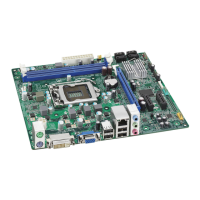Intel Desktop Board DH61BF Technical Product Specification
28
1.15 Power Management
Power management is implemented at several levels, including:
• Software support through Advanced Configuration and Power Interface (ACPI)
• Hardware support:
Power connector
Fan headers
LAN wake capabilities
Instantly Available PC technology
Wake from USB
PCI Express WAKE# signal support
Wake from serial port
Wake from PS/2
Wake from S5
1.15.1 ACPI
ACPI gives the operating system direct control over the power management and Plug
and Play functions of a computer. The use of ACPI with this board requires an
operating system that provides full ACPI support. ACPI features include:
• Plug and Play (including bus and device enumeration)
• Power management control of individual devices, add-in boards (some add-in
boards may require an ACPI-aware driver), video displays, and hard disk drives
• Methods for achieving less than 15-watt system operation in the power-on/standby
sleeping state
• A Soft-off feature that enables the operating system to power-off the computer
• Support for multiple wake-up events (see Table 8 on page 30)
• Support for a front panel power and sleep mode switch
Table 6 lists the system states based on how long the power switch is pressed,
depending on how ACPI is configured with an ACPI-aware operating system.
Table 6. Effects of Pressing the Power Switch
If the system is in this
…and the power switch is
…the system enters this state
Off
(ACPI G2/G5 – Soft off)
Less than four seconds
Power-on
(ACPI G0 – working state)
On
(ACPI G0 – working state)
Less than four seconds
Soft-off/Standby (note)
(ACPI G1 – sleeping state)
On
(ACPI G0 – working state)
More than six seconds
Fail safe power-off
Sleep
(ACPI G1 – sleeping state)
Less than four seconds
Wake-up
(ACPI G0 – working state)
Sleep
(ACPI G1 – sleeping state)
More than six seconds
Power-off
Note: System can only enter Standby state if power switch action is properly configured by the
operating system.

